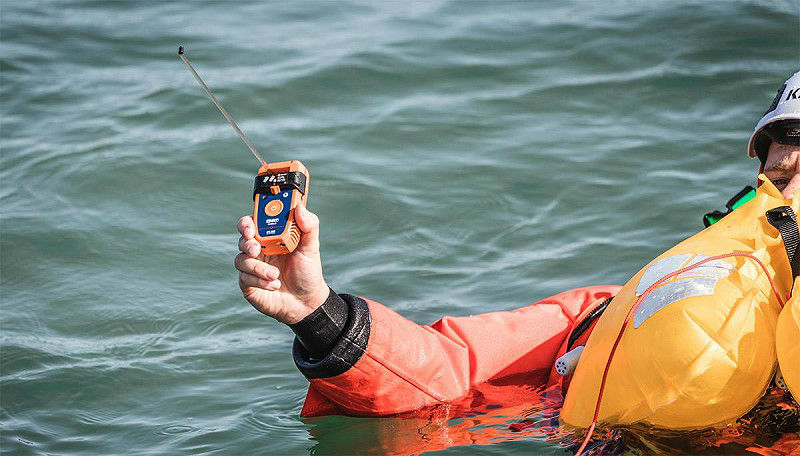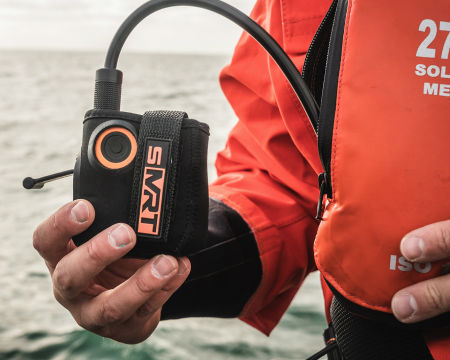What is a Personal Locator Beacon (PLB)?.
A personal locator beacon, or PLB for short, is a personal electronic transmitting device that is designed to alert potential rescuers to a life-threatening situation in the air, on water or in remote areas. When activated, the PLB sends out a signal on either a 406MHz frequency or Local Area System using 121.5MHz, VHF DSC and/or AIS.
Example scenarios of when a PLB may be required are:
- Man overboard
- Skier caught in a landslide
- Hiker lost or trapped and unable to call for help
- Helicopter ditching
How Does a PLB Work?
The way a PLB works can vary based on devices and the technologies inside. When a PLB has been activated, the help or assistance can come from rescue authorities, colleagues, friends or nearby monitoring assets, depending on the type of PLB and the receiving equipment used.
All distress beacons send signals on specific and dedicated frequencies/technologies that operate worldwide. Some require bespoke receiving equipment to transmit messages to, while others work with already established worldwide radio and electronic monitoring equipment.
In simple terms, the way a PLB distress process works is as below:
- A PLB is activated, and a distress signal is transmitted from a PLB/EPIRB/ELT.
- The signal is received by the COSPAS SARSAT satellites.
- The satellites send the signal to the nearest receiving stations on earth known as Local User Terminals (LUTs).
- A Local User Terminal forwards the message to a Mission Control Centre (MCC).
- When a signal is received and identified to be a distress call from a specific area, the Rescue Coordination Centre (RCC) in that area is alerted.
- Local search authorities are informed of the location of the distress alert and travel to rescue the person in danger.
The process exactly will depend on the specific technologies and frequencies used by the beacon, however, the aim is always the same, to locate and rescue the person in danger, as quickly as possible.
Do you need a PLB?
This depends, on what you are planning to do. If you are working or taking part in recreational activity in an environment where there is a likelihood that you may fall into a body of water, or where you may end up stranded in a remote location with no means of calling for help, you should be equipped with a Personal Locator Beacon.
In certain commercial industries and locations, being equipped with a PLB is common practice, if not mandatory and in October 2019, the Maritime and Coastguard Agency (MCA) mandated that crew onboard UK fishing vessels of a certain size should be equipped with a PLB.
Throughout Europe and most of the world, in the offshore industry, you will find it almost impossible to get offshore without a PLB integrated into your life jacket (PFD). ETSI and RTCM are the international safety standards governing Europe and U.S.A respectively. Coming into trouble when nobody else is around, and or when telephone signals are not available, a PLB is a perfect solution for acquiring help and rescue from local search and rescue teams.
What are the different alerting technologies?
There are varying methods of technologies and frequencies that PLBs use, these depend on the beacon as well the scenario that you may find yourself in. These are:
- 121.5MHz - (International Air Distress [IAD]). Only used in marine environments these PLB signals are received by dedicated and bespoke receiver units fitted to aircraft, vessels and the like.
- VHF DSC – (Very High-Frequency Digital Selective Calling). Only used in marine environments these PLBs use the marine VHF radio band to transmit DSC distress alerts and updated GPS positions regularly from the casualty in the water to VHF DSC radios within a local area.
- AIS – (Automatic Identification System) is an automated tracking system that displays other vessels in the vicinity. It is a broadcast transponder system that operates in the VHF mobile maritime band.
- 406MHz – A 406MHz PLB works across both marine and land environments and their signals are received by the COSPAS SARSAT satellites, the international satellite system for search and rescue.
You can find out more about the different frequencies and technologies used by a PLB here where we explain, in detail, how each works.

What are the different activation methods of a PLB?
The way a PLB can be activated varies between devices and how the wearer is carrying it or has access to it. The three different methods of activation are:
- Manual activation requires the user to activate the PLB. Manually activated PLBs are most commonly activated by those on land, who are engaging in recreational activities, or who are travelling into remote areas. The user may be wearing a waist belt with the PLB attached via a pouch or a rucksack and when required the user simply removes the PLB from its pouch and manually activates it. In a commercial environment manual activation, only PLBs should be avoided.
- ‘Semi-automatic’ activation is for use for those going onto a body of water, as the PLB relies on the inflation of the life jacket (PFD) to pull a release clip from the PLB. These PLBs rely on the PFD. These are an improvement and potentially safer option to a manually activated PLB, however, it still leaves several scenarios where the wearer would still be at risk.
- Automatic water activation is most commonly found in commercial working environments and offshore safety; automatic activation is a PLB that activates on immersion in water. A true automatic PLB is equipped with water sensors that will activate the PLB within 2-5 seconds of the PLB being submerged in water. This ensures the PLB will send a distress alert and your position as soon as the casualty enters the water; whether the life jacket activates or not, whether they are unconscious, injured or incapacitated in any other way.
A Brief History of the PLB
The first form of locating beacon was a 121.5MHz ELT (electronic locating transmitter), which was designed solely as an automatic locator beacon for crashed military aircraft so that the wreckage could be found.
The technology wasn’t utilised in a personal device, until the 1970s, when Hull-born David Marshall, who, in 1960, aged just 20, suffered his own man overboard (MOB) incident, in the South Pacific, he was later rescued and returned to the U.K.
Following this, in 1975 David invented and supplied a prototype of the first Personal Locator Beacon to GBII Joint Services for their entry into the Financial Times Clipper race to Australia, going on to commercially launch a PLB specifically for locating man overboard casualties, in 1979.
The inception of the International Cospas-Sarsat Programme, a satellite-aided search and rescue initiative, in 1982, accelerated the development of the Search and Rescue network and technologies, leading to the creation of the 406MHz PLBs.
Want to find out more?
If you would like to find out more about our range of personal locator beacons, then don’t hesitate to get in touch with us today via info@mrtsos.com.
Article First Written:
10/02/2018
- What is a Personal Locator Beacon (PLB)?
- How Does a Personal Locator Beacon Work?
- What are the different types of PLBs?
- What are Local Area Systems?
- What is ELIFE?
- What is a True Water Activating PLB?
- What is the difference between a PLB and an EPIRB?
- What Is AIS, VHF and DSC?
- What is a 406 MHz PLB?
Contact Us
Find Us
Marine Rescue Technologies Limited
Wescom Group,
Unit J1, Springfield Way,
Anlaby, HU10 6RJ


